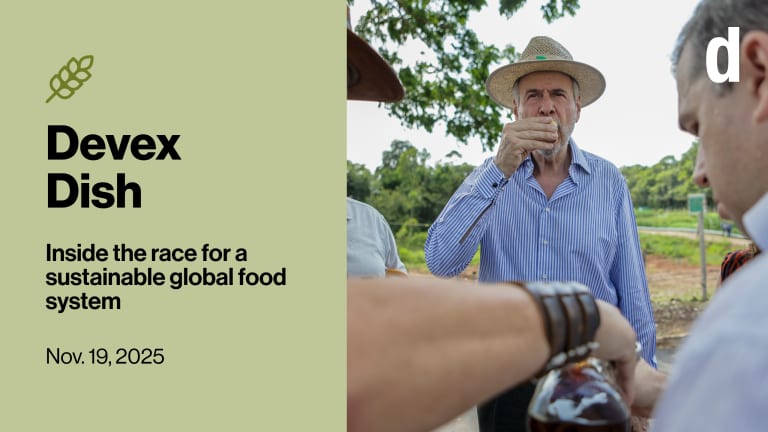
There is widespread agreement that to meet the Sustainable Development Goals, tackle biodiversity loss, and combat climate breakdown, we need to transform the way the world produces, consumes, and thinks about food. But despite this consensus, development finance for food and agriculture is continuing with business as usual.
As the first global meeting of all 450 public development banks kicks off in Paris this week, it is vital that they rethink their priorities for food and agriculture funding. Without this, their collective aim to channel their $2 trillion of annual investments toward transforming societies for sustainable and resilient development stands little chance of success.
The global food system holds huge importance for economies and livelihoods. Growth from agriculture is two to four times more effective in reducing poverty compared with other sectors, and agriculture can be responsible for over 25% of gross domestic product in some countries.
But this economic importance currently comes at a high cost; the current food system threatens the health of both people and the planet. Yet under the guise of development, investments are being made in industrial-scale agriculture that is far more effective at lining the pockets of shareholders than feeding the families of farmers.
Nowhere is this so stark as for livestock production. Experts project that the livestock sector could account for 49% of the world’s emissions budget allowed under the target of 1.5 degrees Celsius by 2030, if the sector continues with business as usual.
Opinion: Support animal health systems to prevent the next pandemic
Infectious disease transmission from animals to humans is increasing — in frequency, virulence, and devastation. This op-ed explores three ways to prevent future pandemics and global health crises.
Increased deforestation for cattle ranching and feed grains in the global south, as illustrated by the rapidly rising deforestation rates in the Amazon, Chaco, Cerrado, and other biomes, is also contributing significantly to increased greenhouse gas emissions at a time when the Intergovernmental Panel on Climate Change suggests that ecosystem restoration is critical to keeping warming to 1.5 C.
These trends are also exacerbating existing inequalities, as Indigenous peoples and local communities face displacement, criminalization, and violence. Business as usual is clearly not an option.
The track record of development finance institutions in funding pro-poor, socially responsible, and sustainable livestock production is troubled. Recent investigations show that the European Bank for Reconstruction and Development and the International Finance Corporation, the World Bank’s commercial arm, have plowed $2.6 billion into unsustainable models of factory farming, industrial meat production, and megadairies over the past decade — including into some of the world’s largest corporations.
IFC reportedly bankrolled the expansion of Brazilian beef producer Minerva — while linked commitments on zero deforestation and slave labor in its supply chains failed to fully materialize — and supported the expansion of pork giant Smithfield Foods in Romania at the expense of local hog farmers. And Brazilian development bank BNDES is the largest minority shareholder in JBS, providing financial fodder to the Brazilian butcher’s rapid expansion against a constant backdrop of scandals involving alleged corruption and deforestation.
These are just three examples of many. Only 55% of World Bank investments in livestock over the last three years are designed with climate change mitigation and adaptation in mind. And when they are, they fail to account for the growth of the sector as a contributing factor.
Let us be clear: These investments are not supporting food security, are increasing global greenhouse gas emissions, perpetuate violations of local rights, and often heighten gender inequality.
So while DFIs may argue that investments in multinational livestock corporations fuel job creation and help feed the world, in reality they often come at the cost of rural livelihoods, stall progress on the SDGs, and undermine the Paris Agreement. And as pandemic prevention shoots up the agenda of DFIs, the role of intensive livestock production in driving zoonotic disease will need to be addressed too.
If they [DFIs] want to achieve the SDGs, they need to recognize the true costs of industrializing agriculture.
—But it doesn’t have to be this way. Examples and evidence of more sustainable livestock production practices exist, despite being threatened by the promoted expansion of industrial livestock and feedstock production.
Supporting communities to control the way food is produced, traded, and consumed can help alleviate poverty and hunger — the aim of SDG 2 — and build more resilient food systems. Imagine if we had invested in women-led local initiatives, land access and tenure initiatives, the promotion of local food production, local supply chains, and smallholder farmers, rather than the millions that have financed further destruction of valuable ecosystems, displaced Indigenous peoples and local communities, and undermined our common climate goals.
DFIs undoubtedly have a vital role in ensuring the right to food and healthy diets and in addressing the environmental and social impact of industrial agriculture. But if they want to achieve the SDGs, they need to recognize the true costs of industrializing agriculture — not provide them financial fuel and not attempt to mitigate them with weak social and environmental standards.
Financing the SDGs, tackling climate breakdown, and preventing pandemics can be one and the same. It is time for DFIs to divest from industrial animal agriculture and invest in smallholder agroecology.









